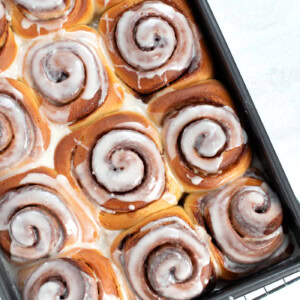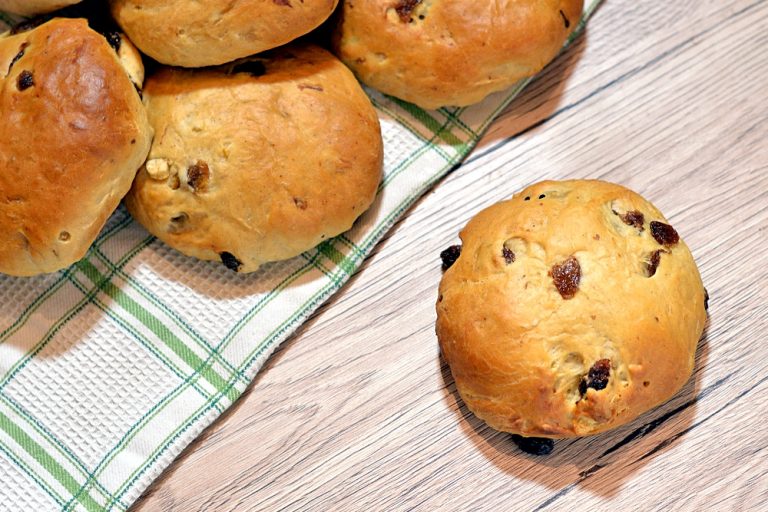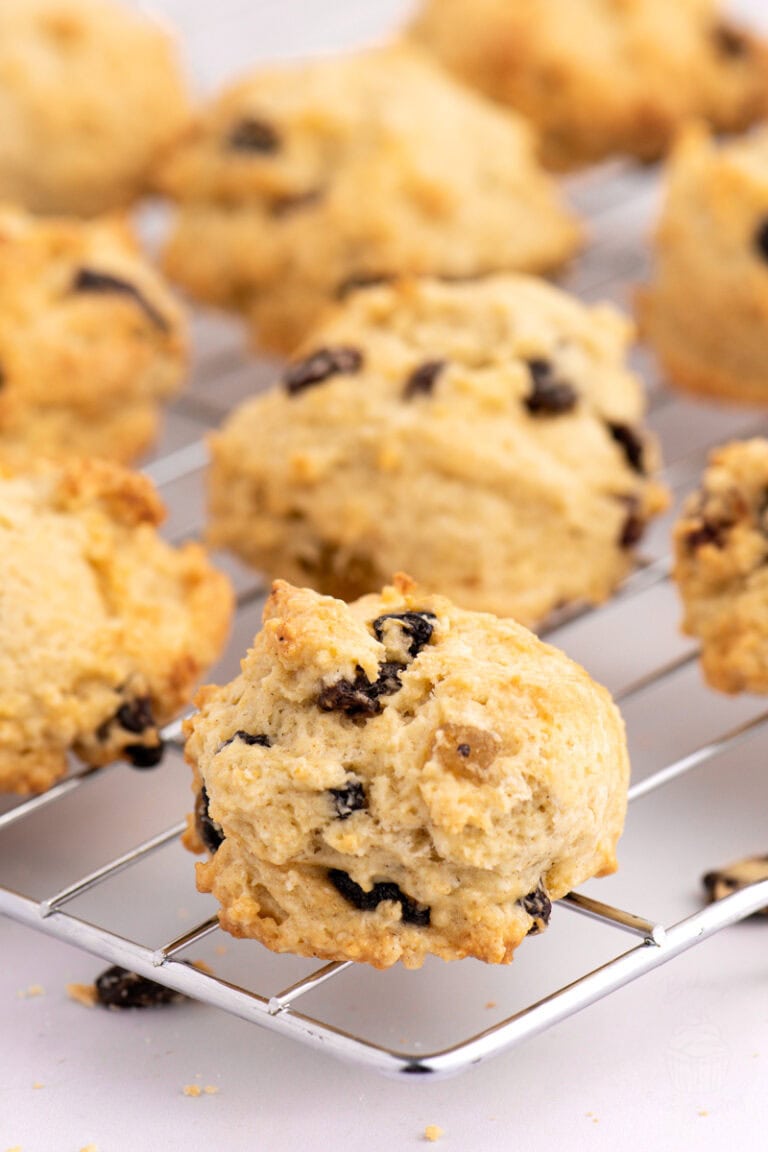Cinnamon Buns (UK Recipe)
After years of trying to find an American-style Cinnamon Bun recipe in the UK, I made my own. The best you’ll ever have, this side of the Atlantic! First things first. This is technically not a new recipe. In fact, I first published this UK recipe for Cinnamon Buns back in 2016, when Baking with Granny…
After years of trying to find an American-style Cinnamon Bun recipe in the UK, I made my own. The best you’ll ever have, this side of the Atlantic!


First things first. This is technically not a new recipe. In fact, I first published this UK recipe for Cinnamon Buns back in 2016, when Baking with Granny was still just a baby. As were my kids, for that matter!
Now that my kids are a bit older and obsessed with all things American (which seems to be where they associate Cinnamon Rolls with, despite them originating from Sweden), they have been asking me for a while to make some Cinnamon Rolls. I revisited this UK recipe for Cinnamon Rolls and thought it was long overdue for a bit of updating.
Please don’t worry if you’ve had this recipe bookmarked since 2016; the changes I’ve made are only minimal. I have taken on some of the feedback from bakers who have made them, as well as updating the recipe instructions for those of us who don’t (or no longer…RIP my Kenwood) have a stand mixer.
This UK recipe for Cinnamon Buns is everything you could ever want from this breakfast favourite. Soft doughy buns, filled with scrumptious cinnamon flavours, and topped with sweet sticky icing.
Plus, my kids said these are the best things I have ever made. EVER. Yes, really!


Ingredients for Cinnamon Buns:
Milk
Cinnamon Buns are made with a rich, sweet yeast dough. This means we have milk, butter, sugar and eggs in the dough – all the good stuff! In terms of milk, a full-fat milk is superior…but not essential. I have also had good success using soya milk in cinnamon buns, and think coconut milk would be great too.
Butter or Margarine
It is a personal preference which you choose to use. For the richest, most indulgent Cinnamon Buns, butter is best. However, most buns you buy in the shop will actually use margarine, as it’s a cheaper ingredient, and the difference in taste is hardly noticeable by the time you have your cinnamon and icing on board too.
If using margarine, just be sure to use a block margarine, as opposed to the spreadable kind. The latter will make your dough too soft and hard to work with.
Flours
I like to use a combination of Strong Flour and Plain Flour for Cinnamon Rolls. I find this gives a good balance of the dough having the extra gluten from the Strong Flour, whilst also managing to maintain a bit of softness with the Plain Flour.
If you only have one or the other, don’t worry – just total your individual flour quantity to 550g. It will still be a successful Cinnamon Bun, although the texture may vary slightly.
Caster Sugar
Previously, I suggested using Granulated Sugar in this UK recipe for Cinnamon Rolls; however, I have now changed this to Caster Sugar. Why? Well, the choice to use granulated sugar was because most American recipes used this (I’m not 100% sure, but I think it’s the most popular kind of sugar used for baking in the States). Here in the UK, we mostly use Caster Sugar in our baking, so it made sense to use it in this recipe too. I also find Caster Sugar disperses better in a yeast dough, due to its finer texture.
You could also use a Golden Caster Sugar if you prefer a slightly less-sweet and more caramel flavour.
Easy Bake Yeast
There was a time when you could buy various types of yeast, but nowadays, Easy Bake Yeast is the most accessible. It also works brilliantly in many recipes, but especially in Cinnamon Buns, as no extra measuring or preparation is required to activate it.
Free-range Eggs
As mentioned, this is a rich yeast dough, and eggs play a big part in that. Not only do they add flavour, they also add moisture, help bind the ingredients together and add a lovely golden colour to your dough.
The size of the egg is not crucial; just be sure to use free-range.
Ground Cinnamon
Of course, any good Cinnamon Roll needs a good dose of Cinnamon. You can use as little or as much as you like, even adding some extra to the dough, should you wish.

Tips for UK Recipe Cinnamon Rolls:
• You can make these Cinnamon Rolls in two parts overnight, so you have delicious, freshly baked buns for breakfast. Simply pop your dough into the fridge to prove (step 4) overnight. Then take it out of the fridge in the morning, let it warm up a little before continuing through the steps as normal.
• You can just use a knife to cut your dough, but I find it much easier, and results in neater rolls, when you use a piece of thread. Simply take a length of thread, place it under your dough where you want to cut it, take the two ends and pull them together & past each other (as if you are trying to tie a knot in your dough). This also gives you rounder rolls as well, as you aren’t flattening your dough as the knife cuts through it.
• Cinnamon not your thing? Why not replace the filling with some Nutella, jam or Biscoff spread.
• I recommend using a metal baking/roasting tin for this UK recipe for Cinnamon Rolls. Having experimented with different types of trays, tins and dishes, I find a metal tin to be the best for an even bake. This Masterclass one is my favourite and what you see in the photos. It is, of course, possible to use a ceramic dish; however, you may need to adjust your oven temperature and baking time to ensure the buns in the middle are baked through.

Save this recipe!
Want to save this recipe for later? Pop your email below and come back to it when you’re ready to bake.

Cinnamon Buns (UK Recipe)
INGREDIENTS
For the Dough
- 200 ml Milk
- 115 g Butter or Margarine (at room temperature)
- 300 g Strong White Flour
- 250 g Plain Flour
- 140 g Caster Sugar
- 7 g Easy Bake Yeast (usually 1 sachet)
- 2 Free-range Eggs (beaten)
For the Filling
- 100 g Butter or Margarine (at room temperature)
- 100 g Caster Sugar
- 1-2 tbsp Ground Cinnamon
For the Icing
- 200 g Icing Sugar
- 1 tsp Vanilla Extract
- 2-3 tbsp Milk
INSTRUCTIONS
For the Dough
- In a small pan, warm the milk & butter/margarine until it's lukewarm (not hot!) and the butter/margarine is melting.
- Meanwhile, sift the flours into a large bowl. Gently mix the sugar and yeast through to combine. Add the milk mixture and stir in a little, before adding the eggs too. Mix until you have a soft, slightly sticky dough.
- Transfer the dough to well-floured surface, and using well-floured hands, knead the dough for around 10 minutes.
- Place the dough into a oiled bowl (to prevent it from sticking) and cover with an oiled piece of cling film, or a damp tea towel. Leave to rise in a draught-free location for 1-2 hours, or until it has doubled in size.
- Once your dough has doubled in size, turn it out onto a lightly floured surface and using a rolling pin, roll it into a rectangle around 45cm x 30cm in size. It's important to make sure your dough is of even thickness all over to ensure you have nice neat buns.
For the Filling
- Lightly grease a large baking/roasting tin (I use a 35cm x 24cm one) and set aside.
- In a small bowl, mix the butter/margarine, sugar and cinnamon together. Spread the mixture evenly over your rolled dough, bringing it right to the edges.
- Roll the dough tightly & evenly, from the long side to long side, to create a 45cm sausage. Cut the sausage into 12 individual rolls – I tend to cut in half, quarters and then thirds to make sure I get even rolls. Arrange the rolls in your pre-prepared tray with plenty space between each roll & the edges (they need space to grow!). Cover loosely with lightly greased cling film or a damp tea towel.
- Leave to rise in a warm place for 1-2 hours until they look light and puffy.
- After your buns have gone through their second rise, remove the cling film and place the tray in a pre-heated oven at 180°c (160°c for fan assisted ovens or Gas Mark 4) and bake for around 20-25 minutes until golden brown.
For the Icing
- Mix together the icing sugar, vanilla extract and milk to create the icing. You can add more or less milk depending on your preference for how thick an icing you would like.
- Spread/pour evenly across the buns shortly after the come out the oven. Leave your cinnamon buns to cool a little until they are just warm and enjoy.
IMPORTANT NOTE:
All my recipes are developed using a digital scale and the metric system (grams and millilitres). Cup measurements are available as a conversion but these, unfortunately, won’t always be as accurate. For best results, I always recommend baking with a digital scale.
RECIPE NOTES:
- Cinnamon Buns are best enjoyed on the day they are baked, but will keep a couple of days when stored in an airtight container.
- You can add a little cinnamon to the dough, if you like a really cinnamon-y flavour.
- The amount of icing stated is enough to give a nice glaze to the top of each bun, but if you want a really thick layer of icing, simply double the icing ingredient quantities.
- You can do an overnight rise with these Cinnamon Buns. Simply place the dough into the fridge to prove (step 4) overnight. Remove the dough from the fridge when you get up and allow it to warm up a little before continuing with the remaining steps as listed.
Cinnamon Rolls – or Cinnamon Buns – are one of the most delicious bakes, which are also surprisingly easy to make. Originally from Sweden (hence why they sell them in Ikea!), Cinnamon Buns have adopted many variations around the globe. Some recipes, like my Easy Cinnamon Swirls, use a puff-pastry dough, but for the most part, they are made with a yeast dough.
Inside, you will find a buttery, sugary, cinnamon mixture. This is rolled within the dough before its second rise.
Finally, Cinnamon Rolls are generally finished with some kind of sweetness on top. This may be some sugar nibs, or like these UK recipe Cinnamon Rolls, a deliciously sticky icing. In the States, you’ll often find Cinnamon Buns with a cream cheese icing – I’m not a big fan of this, partly because it means you then need to keep them refrigerated, but also I find a cream cheese icing to be a little unpredictable to work with.
Cinnamon Rolls are made with a rich, sweet, yeast dough. And this dough is super easy to make! Other than warming your milk & butter, you simply chuck all the ingredients in the bowl and mix, then knead.
The dough is left to prove before being rolled out to a large rectangle, which you then smother with a sugary, cinnamon, butter mix.
Next, you roll them up and then cut into your individual buns. A second rise is necessary before baking your buns to perfection.
Then simply finish with some sweet, sticky icing.

Originally published in August 2016. Updated in August 2023.






These sound wonderful, but we couldn’t possibly eat 12 within a week, are these freezable ?
Superb. Family favourite.
I am making these at the moment, dough has risen almost out of the bowl ;-) they are on there second proof. Fingers crossed. Hubbys favourite, I wonder if you can freeze them?
Amazing, doesn’t use a lot of dishes not a lot of cleaning up and very fun to make and delish!
I have just made these and OMG, they are AMAZING. This is another recipe that I’ll definitely be making again and again. ❤️